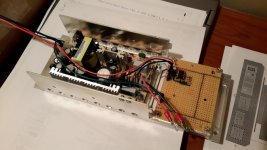Holmes
Experienced Member
oops - error
If I'm reasonably sure I've fixed the problem, I'll go ahead with replacing the power supply, as I have it sitting right here. I didn't want to introduce another variable to the computer if it could be helped, but now it looks like the issue has been resolved. I don't like running this computer off the cheap 220V transformer, as I can't be sure how clean the power is coming out of it, and it's just a pain.
So this is my first experience with Caig's DeOxit, and I must say I'm impressed with it!
Thanks!
I tested it again, and this time ran for over an hour, and doing lots of stuff, running programs, playing music through the internal speaker, etc. It ran like a champ! I even ended it with a series of bumps and knocks, and it still ran perfectly!
I don't feel secure enough to make the changes in the power supply you've suggested. I don't have the foundation of knowledge to troubleshoot such a change in the power supply electronics, and chances are high I would miss something that would be obvious to someone who understood what they were doing, and then, KABOOM.
I'll just be happy switching out the power supply for something smaller and very likely more efficient.
Thanks for the suggestion, though!
Thanks!
I tested it again, and this time ran for over an hour, and doing lots of stuff, running programs, playing music through the internal speaker, etc. It ran like a champ! I even ended it with a series of bumps and knocks, and it still ran perfectly!
I don't feel secure enough to make the changes in the power supply you've suggested. I don't have the foundation of knowledge to troubleshoot such a change in the power supply electronics, and chances are high I would miss something that would be obvious to someone who understood what they were doing, and then, KABOOM.
I'll just be happy switching out the power supply for something smaller and very likely more efficient.
Thanks for the suggestion, though!
Congratulations on fixing the machine.
Just wanted to add that your plan to use a Microcontroller to produce 50hz is a bit too complicated I think (sorry don't get me wrong). You can reproduce the 50Hz reasonably well with a small circuit using a 555 timer chip and some passives. I did this when I had to replace the power supply on my 710, the big brother of the 610.
Congrats again on fixing this little gem!
André
Sent from the mobile client - Forum Talker
If the input capacitor is already a series of two capacitors, you just need to add a single wire jumper. The configuration you should end with it's called "full wave voltage doubler/multiplier", you can see it here:
https://www.electronics-tutorials.ws/blog/voltage-multiplier-circuit.html
But anyway, I know one must feel comfortable to modify line voltage equipment
Frank
Hey Frank,
I thought about your "single wire jumper" solution, and I looked out on Zimmer.com, and found schematics for the power supply here:
http://www.zimmers.net/anonftp/pub/cbm/schematics/computers/b/4256004-01-left.gif
http://www.zimmers.net/anonftp/pub/cbm/schematics/computers/b/4256004-01-right.gif
On the left page, I saw there's a component labelled "E1", and it has "115VAC" written above it. I wonder if they designed this power supply to be switched easily between 220V and 110V via this jumper.
I did a similar thing on my BBC Micro Model B. In that power supply, there's a well documented modification which involves a simple wire you can solder in which converts it from 220V to 110V, and it worked great.
The issue with my B128 power supply is that I took it apart, and could not see anything resembling the "E1" indicated on the PCB. Also, I suspect my power supply does not match the above schematic, as I spot checked some other components and they did not match up.

Thanks!
Yes, I guess using a microcontroller is a bit of overkill for simply generating a 50Hz signal. From a builder perspective, it's very easy and economical, as the board is inexpensive, and it's all on a small 1" x 1" PCB with mounting holes, and the code is extremely simple. Definitely, building a circuit from a 555 timer is much more "correct" for a vintage computer such as this.
One other benefit from using the Digispark is that I have been also thinking of adding a small fan, and making it temperature controlled. If I go that route, then the microcontroller would be useful to have, as it can read the temperature and control the fan as well.
Could you post a schematic of the circuit you designed for your 555 timer, or describe what components you used and the values of resistors/capacitors for your circuit? I looked at how to design one online, and it looked complicated to me, and I wasn't sure about the mathematics of choosing components, as I've never built such a circuit.
Sorry for the late reply. You can find a circuit for 50Hz generation here: http://www.6502.org/users/andre/csa/pwr/csa-pwr-v1.3b-1.sch.png (from the power supply of my self-built 6502 computer)
Regards,
André
Edit: oh I see you've already found something! Sorry again for the late post.
Very cool. My B128 came with no power supply at all.. hoping to create one somehow. This gives me hope.
